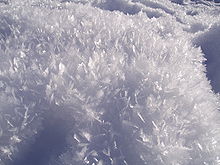Science of the Ski
Cross-Country Skiing
Cross-country skiing or nordic s kiing
is a sport that involves sliding over snow on long, slender
“boards.” Unlike downhill skiing it is performed in varying terrain:
Uphill, downhill and flat. Because weight is more of a concern and
stability less so than downhill skiing, the skis tend to be much
narrower.
kiing
is a sport that involves sliding over snow on long, slender
“boards.” Unlike downhill skiing it is performed in varying terrain:
Uphill, downhill and flat. Because weight is more of a concern and
stability less so than downhill skiing, the skis tend to be much
narrower.
Forward motion on the flats and uphills is achieved in 1 of 2
techniques: classic and skate. In classic skiing, part of the ski's
base is roughed up or a hydrocarbon material is applied to it to
increase friction with the snow. Movement is achieved by pushing off
on one ski, while swinging the other ski and leg forward and then
letting the momentum transfer into glide. This is then repeated on
the other side. For a video click this link.
Forward movement in skate skiing is achieved by placing the ski
diagonal to the direction of and then pushing out perpendicular to
the direction of motion. The vector of this force has components in
both the forward and lateral directions. The result of this is a
motion forward and across to the other ski, where the same action is
performed again. For a video click this link.
In both techniques poles are used to supplement the forward force,
but for the purpose of this website they will be ignored.
It’s All About Friction
While on a good day it may seem like it takes no effort to get a
pair of skis to glide the truth is that even on the flats and
downhills there is always a force that will be opposing the
direction of motion. This force is composed of 3 major parts:
gravity, air resistance and friction.
FTotal = Fg + Far +
Ff
On a set course gravity isn’t something that can be changed
and air resistance isn’t affected much by the skis. When looking at
the skis the force of friction is the only changeable force and so
it is a major concern when preparing and manufacturing skis.
To get a better picture of this we can split the force of friction
into 4 parts. Electrostatic, dirt, capillary and dry. While the
electrostatic and capillary forces aren’t actually frictional forces
it makes the picture simpler to define them as such.
Ff = Felec + Fdirt + Fcap
+ Fdry
The electrostatic force comes from the electric properties of snow
and the ski base. Electrons are transferred from one to the other
creating an electric field. This electric field does not want to
change and so as the ski moves forward there is an electric force
opposing this movement. The force is proportional to the charge
developed on the ski base and the snow and the distance between
them. Where q is the charge and r is the distance between the
charges.
 Felec=(kq1q2)/r^2 k=8.99E9
Felec=(kq1q2)/r^2 k=8.99E9
The friction from dirt is actually a form of dry friction. It occurs
because a ski trail has more than just snow on it. There are
particles of dust, wax and other debris from the environment. This
dirt can get stuck to the ski base from both the electric field and
the wax. The dirt then drags on the snow and creates friction.
The interaction of the ski base and snow crystals creates dry
friction. The sharp points of the snow crystals dig into the base of
the ski and break off or drag, creating friction. This can be
modeled with the equation.
Fdry=ukFn
Where uk is the friction coefficient, which is given depending
on the characteristics of the snow and ski base. Fn is the normal
force, which is equal to the weight being applied perpendicular to
the ski. An interesting note about this equation is that surface
area is absent, meaning that friction does not increase or decrease
with surface area. This will be important when we talk about ski
flex.
Capillary force is due to the stickiness of water. Water molecules
are very polar, meaning the electrons tend to group on one side of
the molecule while the nuclei are on the other. This polarity cause
the molecules to attract and stick to each other. It is the same
reason why it is easier to separate pieces of paper when you lick
your fingers. As a ski glides across the snow the other forms of
friction create heat, which melts a very thin layer of water under
the ski. This layer of water is attracted to itself and the ski
base, creating drag against the direction of motion.
Fighting Friction
When building and preparing a ski, minimizing friction is one the
most important aspects to consider. There are three major parts of
the ski that can affect this friction: Flex,
structure
and wax.
Generally they are in that order for the influence they have. Flex
is the most important while wax is the least.
 Felec=(kq1q2)/r^2 k=8.99E9
Felec=(kq1q2)/r^2 k=8.99E9 kiing
is a sport that involves sliding over snow on long, slender
“boards.” Unlike downhill skiing it is performed in varying terrain:
Uphill, downhill and flat. Because weight is more of a concern and
stability less so than downhill skiing, the skis tend to be much
narrower.
kiing
is a sport that involves sliding over snow on long, slender
“boards.” Unlike downhill skiing it is performed in varying terrain:
Uphill, downhill and flat. Because weight is more of a concern and
stability less so than downhill skiing, the skis tend to be much
narrower.  Felec=(kq1q2)/r^2 k=8.99E9
Felec=(kq1q2)/r^2 k=8.99E9